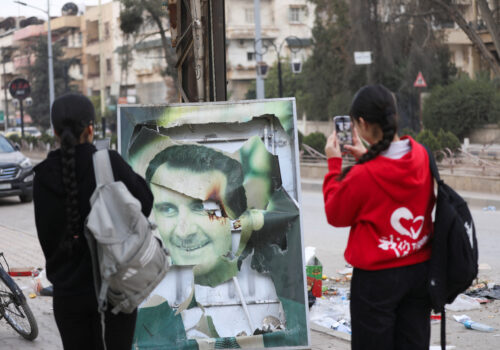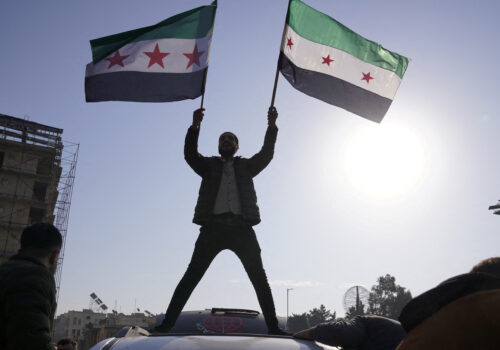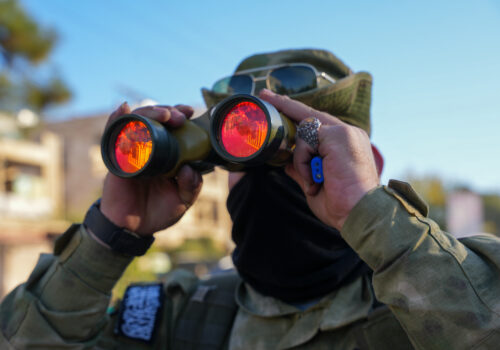A blueprint for bringing about a new Syria
Many Syrians cheered Hayat Tahrir al-Sham (HTS) and its affiliate armed groups as they drove Assad regime elements and their Russian and Iranian backers out of cities and towns in Syria over the past week. But this lionization should be a wake-up call for the civilian Syrian political opposition about HTS’s influence in post-Assad Syria. The forces that opposed Assad now have a sudden and potentially short-lived opportunity to shape the future of Syria, but they will blow it if they are divided.
The first Trump administration, in which I served on the National Security Council, made considerable efforts, in partnership with countries in Europe and the Middle East, to bring together Syrian political opposition groups for talks on a new vision for Syria and on creating conditions for the implementation of United Nations Security Council Resolution 2254, wholly opposed by dictator Bashar al-Assad. The biggest obstacle to their forging a way ahead for Syria five years ago has fled, and he has been replaced by an equally daunting obstacle, the military leader of an internationally sanctioned terrorist group with its own undisclosed vision for the future of Syria.
When Assad was finally forced out of Syria on December 8, it was because of the territorial and popularity gains made by HTS. Any hopes still nurtured by foreign governments of forming a post-Assad transitional government for Syria comprised of civilian political opposition groups alone—excluding HTS, which both the United States and the United Nations have designated as a terrorist organization—will need to be amended. Squeeze a few extra chairs around the table for HTS, the former al-Qaeda affiliate so popular in Syria right now that it would likely welcome free and fair elections. And an election would give the group’s ideology a legitimate mandate. The logical fear of watching a terrorist group regain control in Syria is leading some, like Russian Foreign Minister Sergei Lavrov, to suggest that supporting Assad’s regime against HTS fighters was choosing the least of two evils.
The United States has learned the hard way from experience in Iraq and Afghanistan that for reconstruction to have a shot at success, a few tenets should be adopted:
- Have a single reconstruction strategy.
- All donors must agree to making assistance contingent upon milestones.
- Deviation from the strategy by aid donors or recipients should have consequences.
- Harbor no delusions about the parties involved on the ground.
On the fourth point, it’s possible to recognize HTS’s victory and current popularity without necessarily subscribing to their self-branding. Statements from HTS about their intent to respect minorities should not be interpreted as a sign of moderation in the group’s ideology. These statements are simply a partial and incomplete reflection of related Quranic verses (Surah Al-Baqarah (2:62)), historical covenants the Prophet Mohammed made with non-Muslim communities, and his direction to Muslims and their temporal leaders to protect adherents of other faiths who have peaceful relations with their Muslim neighbors. HTS is not yet showing signs of being even as moderate as the fundamentals that define “fundamentalist Islam.”
The Taliban made similar “campaign trail” promises to protect women’s rights and minorities in order to assuage fears of its ideology among the international community as it retook power in Afghanistan in 2021—and then flagrantly betrayed them. A Taliban spokesman told a press conference in August 2021 that women “can get education from primary to higher education—that means university,” adding “we have announced this policy at international conferences.” Since then, Taliban decrees have barred women and girls from secondary and higher education.
Note that political negotiations in Yemen were upended when the Houthis gained public support for their actions in the Red Sea purportedly on behalf of Gaza, with the increased popular backing making them less willing to make concessions.
Recall protesters hoping to bring down the Lebanese government dancing in Beirut’s streets in October 2019, while Hezbollah continued to plan and operate. The net result was zero change in Lebanon. Optimism is no substitute for planning.
Also note that US President-elect Donald Trump issued a social media statement saying the United States should not get involved in Syria. Likely the only way for the civilian political opposition to Assad to return to center stage and gain advocacy from the next US administration is to quickly present a pragmatic and unified plan for a transitional government, elections, and ongoing governance. This plan should create space for HTS to participate in elections if the group transitions into a political party, defined as unarmed and non-militant. The plan should allow for members of HTS to potentially serve in leadership roles within ministries and the military. In the early days of an interim government, each day that a concrete way forward for governance of Syria is not solidified will strengthen the case for Syria’s Islamist military liberators to take full control themselves.
It will of course be difficult to persuade a victorious HTS to accept such conditions, when it is otherwise likely to dismiss the civilian opposition with a “you and what army?” and pursue a Taliban-esque way forward. Getting buy-in from the United States, the European Union, key Arab states, Turkey, Russia, and China for a plan like this—that precludes HTS and affiliates from a monopoly on the use of force—might be the only way to do so.
Bottom line for the Syrian political opposition: Be ready to speak with one voice to the international community or risk your divisions handing HTS a plurality of support, leading directly to your capitulation to extremist-led governance.
A reconstruction blueprint
When it comes to planning for the country’s reconstruction, the international community has a lot of new leverage in the wake of Assad’s flight. No entity will be able to effectively run the country without near-total dependence on foreign aid. Using that leverage to make sure the reconstruction of Syria unfolds more successfully than Iraq’s or Afghanistan’s should be the next priority.
This is the point in post-conflict scenarios where donors usually muck things up. They pursue divergent reconstruction plans that do not align. They empower competing political actors, hampering decision-making. They fund duplicative projects and leave critical gaps unaddressed. They do not tie funding to milestones, allowing bad actors to abuse and consolidate power while the money continues to flow. The last two decades in Iraq, Afghanistan, and Somalia are catalogs of related lessons learned.
Donors should co-develop a single reconstruction strategy for Syria, then adopt pieces of the strategy for funding and management in accordance with their domestic laws and policies. (For example, the United States cannot provide material support to designated terrorists, which would preclude the United States from funding construction of government offices that would be used by HTS members.)
All donors should be asked to agree to the one-strategy approach, and to tying the flow of funding and official recognition to specific performance milestones for the new Syrian government. If pledges are not kept, the funding stops, and official recognition is withheld or withdrawn.
Any donor country that continues to fund a new Syrian government (transitional or newly elected) while it is in violation of its pledges should face sanctions. In the event of violations, China, Russia, and Iran will not feel compelled to comply with the established strategy and could continue funding the new government. This will highlight the comparatively paltry amount of foreign aid these countries provide when compared with the United States, the Gulf, and Europe. (China’s foreign grant spending is roughly one-tenth that of the United States.)
All reconstruction funds should be overseen by a commissioner elected by the donor countries, who acts as a CEO and also chairs an advisory board comprised of representatives from across Syrian demography. This consultative body discusses, debates, and provides recommendations on project prioritization to the commissioner. But the donors call the shots.
Leading with a purpose
The United States lacked a Syria strategy over the past four years, a fact often lamented by countries impacted by the conflict. Granted, US voters have little appetite for toppling more dictators, and US-led nation building in the first quarter of the twenty-first century has not gone as well as it did in the twentieth century. (It has not helped that the same countries that clamor for the United States to lead these more recent efforts have sometimes contradicted US-led objectives with their own policies and wallets.)
Yet the United States is still asked and expected to lead. This time US policymakers should heed lessons learned in places like Iraq, Afghanistan, and Yemen about the dangers of donor misalignment and the difficulty of negotiating with groups that use violence for political ends. And they should listen to those who argue that no terrorist group in the modern Middle East has moderated its ideology upon assuming power.
International partners may not agree at first contact with these tenets for Syrian reconstruction; this is a job for diplomacy. For its own interests, the United States should not agree to lead or participate in any reconstruction effort that does not meet these foundational conditions.
Kirsten Fontenrose is a nonresident senior fellow at the Scowcroft Middle East Security Initiative in the Atlantic Council’s Middle East Programs. Previously, she was the senior director for the Gulf at the National Security Council, leading the development of US policy toward nations of the Gulf Cooperation Council, Yemen, Egypt, and Jordan.
Further reading
Sun, Dec 8, 2024
Assad has fallen. Now what?
Fast Thinking By
The power shift in Syria will reverberate across the Middle East and the world. Our experts explain what's next.
Sun, Dec 8, 2024
Experts react: Rebels have toppled the Assad regime. What’s next for Syria, the Middle East, and the world?
New Atlanticist By
Syrian dictator Bashar al-Assad has been ousted as opposition forces quickly took the Syrian capital. Atlantic Council experts share their insights on the developments.
Thu, Dec 5, 2024
Could Syria’s rebels take Damascus?
New Atlanticist By Qutaiba Idlbi
Controlling Aleppo was a big deal for the Syrian rebels, and taking Hama was an even bigger achievement. But Damascus remains the real prize.
Image: HTS (Hayaat Tahrir Al Sham) leader Ahmed Al-Shara, also known as Abu Muhammad Al-Jolani, commander in the operations department of the Syrian armed opposition praying inside the Great Umayyad Mosque after his troops declared their entry into the capital and the overthrow of Bashar Al-Assad, in Damascus, Syria, on December 8, 2024. Photo by Balkis Press/ABACAPRESS.COM


